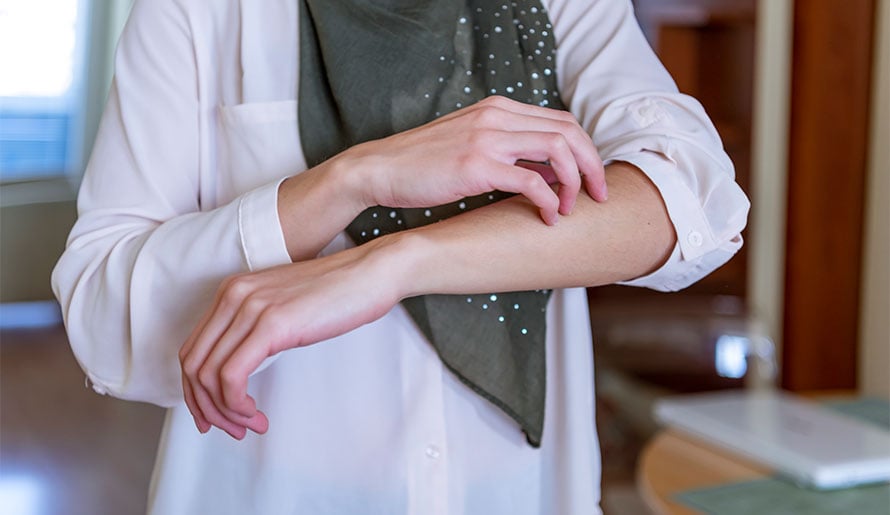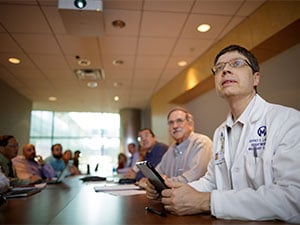What Does a Rash From Hodgkin Lymphoma Look Like?

If you’re experiencing a skin rash, you may be wondering what’s causing it and whether it could be a sign of Hodgkin lymphoma. Although certain other types of lymphoma can cause skin irritation, this symptom is fairly uncommon with Hodgkin lymphoma, which sometimes produces pruritus (itchiness) without a rash. Researchers believe the itchiness is caused by cytokines, which are chemicals released by the body’s immune system in response to lymphoma. Cytokines can irritate nerve endings in the skin, which can in turn cause persistent itching. Many individuals experience this itchiness in their hands, lower legs or feet, while others feel it throughout their entire body. Patients often report that the itching tends to worsen while they are lying in bed at night.
Other Hodgkin lymphoma symptoms
In addition to itchiness triggered by the release of cytokines, individuals with Hodgkin lymphoma may experience the following symptoms:
- Lymph node swelling, particularly in the neck, armpits, stomach or groin
- A low-grade fever accompanied by chills
- Severe night sweats
- Physical, mental or emotional exhaustion
- Unexplained weight loss
- Other issues specific to the location of the lymphoma, such as chest pain, difficulty breathing, or a feeling of being full
Rashes caused by skin lymphoma
Although Hodgkin lymphoma generally doesn’t cause a rash, other forms of lymphoma can. For instance, skin lymphoma—a type of non-Hodgkin lymphoma—can cause skin irritation. There are various types of skin lymphoma, including T-cell skin lymphoma and B-cell skin lymphoma. The most common form of T-cell skin lymphoma—accounting for almost half of all skin lymphoma cases—is mycosis fungoides (MF).
It’s important to note that although skin lymphoma develops in the skin, it’s not a type of skin cancer. What’s more, another type of lymphoma that starts elsewhere in the body and then spreads to the skin is not skin lymphoma.
When a rash caused by skin lymphoma (also referred to as cutaneous lymphoma) is in its early stages, it often presents as small patches of dry, red skin on the torso, buttocks or another area of the body. At this stage, the rash often resembles dermatitis, eczema or psoriasis. Certain areas of skin may also thicken, harden and form plaques that itch and ulcerate. Typically, these plaques develop on the face or buttocks or within skin folds. As a skin lymphoma rash progresses, papules (small bumps) may start to appear. Some individuals with skin lymphoma also experience erythroderma, a reddening of the skin that’s often accompanied by dryness, itchiness and scaliness.
Moffitt’s approach to lymphoma diagnosis and treatment
 If you’re experiencing a skin rash, itchiness or any other symptoms associated with lymphoma, you can turn to Moffitt Cancer Center for a diagnosis and treatment. We take a multispecialty approach to cancer care, and our renowned Malignant Hematology Program includes board-certified surgeons and physicians, medical oncologists, radiation oncologists, radiologists, nurses, researchers and supportive care specialists who work closely together on behalf of our patients. Each week, our tumor board of cancer specialists meets to review complex cases and make any necessary treatment adjustments. Thanks to our collaborative approach, our patients receive the benefit of multiple expert opinions without the need for referrals.
If you’re experiencing a skin rash, itchiness or any other symptoms associated with lymphoma, you can turn to Moffitt Cancer Center for a diagnosis and treatment. We take a multispecialty approach to cancer care, and our renowned Malignant Hematology Program includes board-certified surgeons and physicians, medical oncologists, radiation oncologists, radiologists, nurses, researchers and supportive care specialists who work closely together on behalf of our patients. Each week, our tumor board of cancer specialists meets to review complex cases and make any necessary treatment adjustments. Thanks to our collaborative approach, our patients receive the benefit of multiple expert opinions without the need for referrals.
To request an appointment at Moffitt Cancer Center, call us at 1-888-663-3488 or fill out our new patient registration form online. Something that sets us apart from other cancer treatment providers is our exceptionally quick turnaround time—we connect each new patient with a cancer expert as soon as possible.
